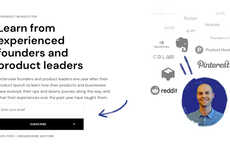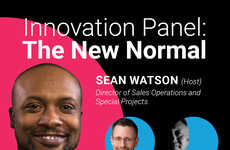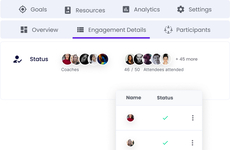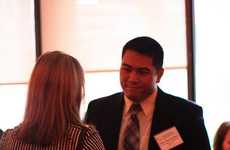
Senduran Bhakthakumaran — March 30, 2012 — Business
References: kenblanchard & entmoney
Ken Blanchard has the ability to masterfully communicate ideas. His caring nature exudes through his intellectual speeches that often have audiences feeling as if he is speaking to each individual person rather than the entire group. The 'One Minute Manager' was co-authored by himself and Spencer Johnson and is now a best-seller. Blanchard is an expert in management and has been recognized through numerous awards such as the 'Council of Peers Award of Excellence issued by the National Speakers Association in 1991 and the Distinguished Contribution to Human Resource Development Award from the American Society of Training and Development received in 1996.
11 Questions with Ken Blanchard
1. How did you get involved in leadership and management, and what motivates you to continue?
My involvement in leadership and management began in the 1960s, when I was an Assistant Dean at Ohio University. The chairman of the management department, Dr. Paul Hersey, asked me if I would be interested in writing a textbook with him. That book became Management of Organizational Behavior. It introduced Situational Leadership®, a whole new way of looking at management. Now in its 10th edition, the book has been a bestseller in the field for over 40 years.
In 1982 the book I wrote with Spencer Johnson, 'The One Minute Manager,' was published and went on to sell more than 13 million copies. I guess you could say that book was a trendsetter, because it was the first well-known business parable, a format that is widely copied today.
When I was on sabbatical in the late 1970s, I gave a speech—“Different Strokes for Different Folks”—at a Young President’s Organization event. People were so excited about it that they insisted my wife Margie and I start our own management consulting company. We went from not knowing how to balance our own checkbook in 1979 to running a company that today has more than 300 employees and offices around the world.
What keeps me motivated to continue is that I believe the world needs a different leadership role model. When you look at leaders around the world—whether they’re running departments or countries, businesses or religious institutions—you see too many people focusing on self-serving goals. We need a new leadership model that focuses not only on goal accomplishment, but also on the greater good.
2. How significant are the topics of cool hunting and trend spotting in the world of management techniques?
It’s very important for leaders to stay on top of trends in the field of management. In the new book I wrote with Mark Miller, Great Leaders Grow, we talk about how critical it is for leaders to open their world and see what’s happening outside their comfort zones. Part of becoming an effective leader is studying trends and seeing what’s useful for solving today’s management problems.
3. Do you need a culture of innovation to create something that is cool?
You absolutely need a culture of innovation not only to create cool things, but also to remain viable and relevant. If you want your organization to survive these days, innovation is not a “nice to have”—it’s a must. Look what happened to Blockbuster and Kodak.
4. What is the best way to create an infectious idea, product or service?
Work with other people and be open to brilliance, especially if creative thinking is not your strong suit. We have a saying around Blanchard that “No one of us is as smart as all of us.” My mother used to ask me why I always wrote with coauthors and didn’t just write books by myself. I’d tell her, “Mom, I already know what I know. I want to learn something new.” When you work with other people, you can tap into collective genius.
5. What is the key to innovation?
For our company, the key to innovation is our Office of the Future. We created a special department whose sole purpose is to spot trends and stay ahead of the current culture. The people in the Office of the Future don’t have day-to-day operational jobs, so their time is free to study innovative ideas and trends. Thanks to our Office of the Future, our company has been able to anticipate changes that have caught other companies off guard.
6. What are the most important trends you see in leadership?
The biggest trend has been the shift from top-down hierarchical management to side-by-side management. In the old days we used to use terms like “superior” and “subordinate” or “department head” and “hired hands.” We didn’t even give employees heads! How can they bring their brains to work if they’re just hired hands? Today there’s a growing recognition that people working in teams and partnerships are happier and more productive. At our company we define leadership as “helping people achieve worthwhile results while acting with respect, care, and fairness for the well-being of all involved.”
7. What are your ambitions for The Ken Blanchard Companies?
Our big, hairy, audacious goal at The Ken Blanchard Companies is that someday everyone will have been positively impacted by leaders who lead at a higher level, for the greater good of all. Making that ambition a reality motivated us to write Leading at a Higher Level, which is our company’s magnum opus.
8. What is an example of a time where you have thrown away an existing idea to force yourself to find something new?
As I mentioned earlier, 'The One Minute Manager' was wildly successful. A lot of writers might have thought they didn’t really have to publish anything else—they could just ride those coattails through their career. While I think the concepts in 'The One Minute Manager' are great, I’ve continued to push the envelope and search out new ideas. I guess that’s why I’ve published more than 40 more books since then!
9. How do you reset yourself to be creative? Do you have any rituals?
I enter my day slowly, with solitude, prayer or meditation, and reflection. In this way I open myself to ideas and inspiration that come from outside my own narrow mindset. I try to re-read my mission, vision, and values each day, which motivates me to be creative and help others.
10. Professionally, what do you want to be doing or studying in 10 years?
With the speed of change, I don’t know what I’ll be doing or studying in ten years. I want to be on top of what’s exciting and new and can help people at that time. I wouldn’t presume to know what that is now. I want to remain a thought leader, which means I’ll be keeping up with the latest management trends. Things are changing so fast now that young people are expected to have three or four careers—careers, not jobs—in their lives. Who knows what the next ten years will bring?
What are your most important hobbies?
My favorite pastime is spending time with the people I love. I’ve learned more from listening to others than from anything else, so that’s my most important hobby. I also love to golf and I’m an avid sports fan. There’s nothing like a great basketball game!
11 Questions with Ken Blanchard
1. How did you get involved in leadership and management, and what motivates you to continue?
My involvement in leadership and management began in the 1960s, when I was an Assistant Dean at Ohio University. The chairman of the management department, Dr. Paul Hersey, asked me if I would be interested in writing a textbook with him. That book became Management of Organizational Behavior. It introduced Situational Leadership®, a whole new way of looking at management. Now in its 10th edition, the book has been a bestseller in the field for over 40 years.
In 1982 the book I wrote with Spencer Johnson, 'The One Minute Manager,' was published and went on to sell more than 13 million copies. I guess you could say that book was a trendsetter, because it was the first well-known business parable, a format that is widely copied today.
When I was on sabbatical in the late 1970s, I gave a speech—“Different Strokes for Different Folks”—at a Young President’s Organization event. People were so excited about it that they insisted my wife Margie and I start our own management consulting company. We went from not knowing how to balance our own checkbook in 1979 to running a company that today has more than 300 employees and offices around the world.
What keeps me motivated to continue is that I believe the world needs a different leadership role model. When you look at leaders around the world—whether they’re running departments or countries, businesses or religious institutions—you see too many people focusing on self-serving goals. We need a new leadership model that focuses not only on goal accomplishment, but also on the greater good.
2. How significant are the topics of cool hunting and trend spotting in the world of management techniques?
It’s very important for leaders to stay on top of trends in the field of management. In the new book I wrote with Mark Miller, Great Leaders Grow, we talk about how critical it is for leaders to open their world and see what’s happening outside their comfort zones. Part of becoming an effective leader is studying trends and seeing what’s useful for solving today’s management problems.
3. Do you need a culture of innovation to create something that is cool?
You absolutely need a culture of innovation not only to create cool things, but also to remain viable and relevant. If you want your organization to survive these days, innovation is not a “nice to have”—it’s a must. Look what happened to Blockbuster and Kodak.
4. What is the best way to create an infectious idea, product or service?
Work with other people and be open to brilliance, especially if creative thinking is not your strong suit. We have a saying around Blanchard that “No one of us is as smart as all of us.” My mother used to ask me why I always wrote with coauthors and didn’t just write books by myself. I’d tell her, “Mom, I already know what I know. I want to learn something new.” When you work with other people, you can tap into collective genius.
5. What is the key to innovation?
For our company, the key to innovation is our Office of the Future. We created a special department whose sole purpose is to spot trends and stay ahead of the current culture. The people in the Office of the Future don’t have day-to-day operational jobs, so their time is free to study innovative ideas and trends. Thanks to our Office of the Future, our company has been able to anticipate changes that have caught other companies off guard.
6. What are the most important trends you see in leadership?
The biggest trend has been the shift from top-down hierarchical management to side-by-side management. In the old days we used to use terms like “superior” and “subordinate” or “department head” and “hired hands.” We didn’t even give employees heads! How can they bring their brains to work if they’re just hired hands? Today there’s a growing recognition that people working in teams and partnerships are happier and more productive. At our company we define leadership as “helping people achieve worthwhile results while acting with respect, care, and fairness for the well-being of all involved.”
7. What are your ambitions for The Ken Blanchard Companies?
Our big, hairy, audacious goal at The Ken Blanchard Companies is that someday everyone will have been positively impacted by leaders who lead at a higher level, for the greater good of all. Making that ambition a reality motivated us to write Leading at a Higher Level, which is our company’s magnum opus.
8. What is an example of a time where you have thrown away an existing idea to force yourself to find something new?
As I mentioned earlier, 'The One Minute Manager' was wildly successful. A lot of writers might have thought they didn’t really have to publish anything else—they could just ride those coattails through their career. While I think the concepts in 'The One Minute Manager' are great, I’ve continued to push the envelope and search out new ideas. I guess that’s why I’ve published more than 40 more books since then!
9. How do you reset yourself to be creative? Do you have any rituals?
I enter my day slowly, with solitude, prayer or meditation, and reflection. In this way I open myself to ideas and inspiration that come from outside my own narrow mindset. I try to re-read my mission, vision, and values each day, which motivates me to be creative and help others.
10. Professionally, what do you want to be doing or studying in 10 years?
With the speed of change, I don’t know what I’ll be doing or studying in ten years. I want to be on top of what’s exciting and new and can help people at that time. I wouldn’t presume to know what that is now. I want to remain a thought leader, which means I’ll be keeping up with the latest management trends. Things are changing so fast now that young people are expected to have three or four careers—careers, not jobs—in their lives. Who knows what the next ten years will bring?
What are your most important hobbies?
My favorite pastime is spending time with the people I love. I’ve learned more from listening to others than from anything else, so that’s my most important hobby. I also love to golf and I’m an avid sports fan. There’s nothing like a great basketball game!
Trend Themes
1. Shift to Side-by-side Management - The biggest trend in leadership is the shift from top-down hierarchical management to side-by-side management, recognizing the value of teamwork and partnerships.
2. Culture of Innovation - Having a culture of innovation is vital for organizations to remain viable and relevant in today's rapidly changing landscape.
3. Trend Spotting in Management - Staying on top of trends in the field of management is crucial for leaders to effectively solve today's management problems.
Industry Implications
1. Management Consulting - The management consulting industry has opportunities for disruptive innovation by helping organizations transition to side-by-side management and fostering a culture of innovation.
2. Publishing - The publishing industry can explore new formats, such as business parables, to create engaging and impactful content for leadership and management topics.
3. Sports and Entertainment - The sports and entertainment industry can benefit from trend spotting in management techniques to improve leadership strategies and enhance the overall experience for fans and audiences.
0.6
Score
Popularity
Activity
Freshness























